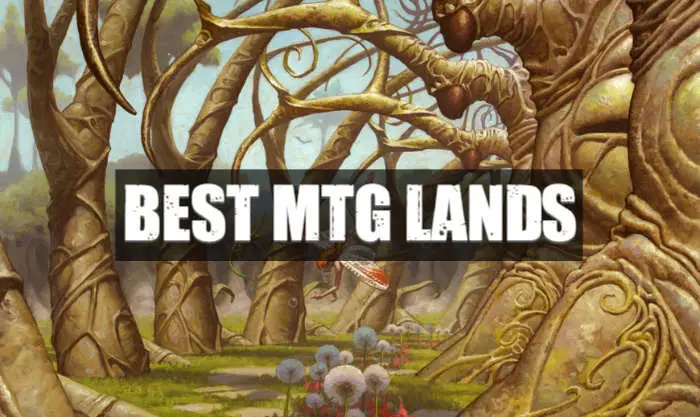Lands are the most important part of a Magic: the Gathering deck. Without them, the rest of your deck can’t function (well, unless you’re playing some weird discard-to-hand-size dredge deck).
Today we’re going to go over the best lands in MTG history. There are countless ways a land can be powerful. It can have a powerful non-mana ability, like being able to transform into a creature. It can produce multiple colors of mana, or multiple mana of the same color.
But regardless of how they do it, every card on this list has one thing in common. They’re all really powerful and have had a big impact on the game of Magic.
Let’s get right into it.
What Makes a Good Land?
In short, to be good, a land simply has to do something useful, while also being efficient enough to be included in competitive decks.
The most common way a land can be useful and efficient is by tapping for two different colors of mana, while having a way to enter the battlefield untapped. The latter part of that equation is important. There are very few good lands that can’t be used on the first turn you play them. They should all (with a few exceptions) be able to enter the battlefield untapped.
While tapping for multiple colors is the most common thing that makes a land useful, it’s definitely not the only one. Others have useful activated abilities that have nothing to do with mana, such as, turning into a creature until end of turn, or giving boosts to your creatures.
I’ll get into those later in the article. For now, however, let’s look at the best that tap for two colors of mana.
RELATED: 2022 Pioneer Challenger Decks And Decklists
Best Duals
Shock Lands
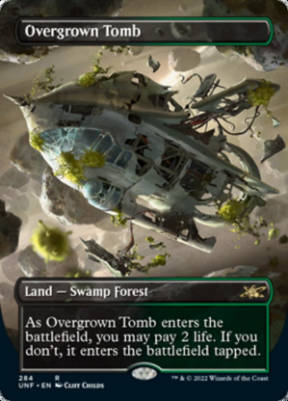
Shock lands were originally printed in the Ravnica block. They can each tap for two different colors of mana and they all have the ability to enter the battlefield untapped. You just have to pay two life. Or, if you don’t need them the first turn, you can let them enter untapped for free.
Shocks are super powerful since, in non-eternal formats, they’re the most consistent way to get access to two colors of mana at once. Aside from the rare scenario when you don’t have two life to spare, you never have to worry about them coming in tapped when you need them.
All of the shock lands can be found below:
- Hallowed Fountain
- Watery Grave
- Blood Crypt
- Stomping Ground
- Temple Garden
- Godless Shrine
- Overgrown Tomb
- Breeding Pool
- Steam Vents
- Sacred Foundry
Fetch Lands
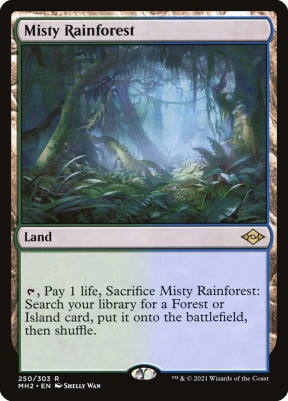
Fetches don’t actually produce mana themselves. Instead, you can sacrifice them to search your library for lands that match one of the basic types of the one you sacrificed.
Fetches got their first printing way back in Mirage. Those fetches, however, were severely underpowered compared to what would come later.
The most powerful fetches debuted in the Onslaught set. These, unlike their predecessors, come into play untapped, letting you use them the same turn you play them.
Another less obvious, but very real, advantage of fetches, is that they thin your deck. Every time you use one, you’re removing an extra land from your library. I’ll give you a quick example to help you understand this advantage.
Let’s say you’re playing a burn deck that uses 20 lands. You’ve drawn three so far. If those three are regular lands, then you still have 17 left in your deck. So at the critical turn-four junction in the game, you would regularly have a 66% chance of drawing a useful spell instead of a land.
If those three were all fetches, however, you would only have 14 left in your deck instead of 17. You would now have a 72% of drawing a useful spell.
While a 2% increase per fetch might not seem crazy, it’ definitely makes a difference.
Fetches also have the advantage of giving extra landfall triggers, as well as giving players an opportunity to shuffle their libraries on the spot.
With all this in mind, it’s no surprise that fetches have gone on to shape the modern format. These powerful cards have become staples in almost every single multi-colored (and even some mono-colored) decks.
All of the fetch lands are below:
- Flooded Strand
- Polluted Delta
- Bloodstained Mire
- Wooded Foothills
- Windswept Heath
- Marsh Flats
- Scalding Tarn
- Verdant Catacombs
- Arid Mesa
- Misty Rainforest
Original Alpha/Beta Duals
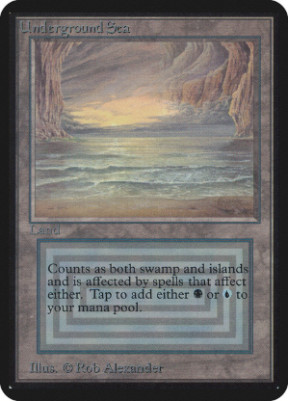
This cycle started it all, and are to this day, easily the most powerful in all of Magic: the Gathering.
These are as simple as it gets. They each provide you with two different colors of mana, they enter the battlefield untapped, and there are zero restrictions or downsides.
Furthermore, these original duals all have their two respective basic types, meaning they’re fetchable.
The original duals have been a big part of MTG since the very beginning of the game, and remain so to this day. They are the most useful option in every single format they’re legal in, and are almost obligatory in Legacy, Vintage and cEDH.
The original dual lands:
Fast Lands

As their name implies, these are extremely useful for faster decks that don’t require more than a few mana sources per game.
They provide you with two colors of mana, and they come into play untapped if you control two or fewer other lands.
While these aren’t nearly as powerful as the previous ones on our list, they’re still some of the best in the game. When legal, they’re extremely useful in rotating formats like Standard. And even in Modern, they’re still great in the right decks.
Naturally, these are risky in slower decks. If you consistently need more than three mana per game, you probably don’t want to run very many, or any, of these.
- Darkslick Shores
- Concealed Courtyard
- Copperline Gorge
- Botanical Sanctum
- Seachrome Coast
- Razorverge Thicket
- Blackcleave Cliffs
- Inspiring Vantage
- Blooming Marsh
- Spirebluff Canal
Pain/Horizon Lands

Pain lands let you tap for multiple colors of mana, but also deal damage to you each time you tap them, hence the “pain”. In most situations, these are inferior to shocks.
With the latter, you have the potential to let it come into play tapped if you don’t need it, sparing yourself damage. With pain lands, however, the damage is unavoidable, and usually ends up dealing more than two damage to you.
Horizon lands, however, are another story altogether. Horizons have a powerful added ability. For just one generic mana, you can tap and sacrifice Horizons and you get to draw a card.
This might not seem like a huge deal to some, but it can make the difference between winning and losing late in a game when you star getting mana-flooded. This ability takes an already good concept and pushes it over the edge.
Pain List:
- Ardakar Wastes
- Underground River
- Sulfurous Springs
- Karplusan Forest
- Brushland
- Caves of Koilos
- Shivan Reef
- Llanowar Wastes
- Battlefield Forge
- Yavimaya Coast
Horizon List:
Filters
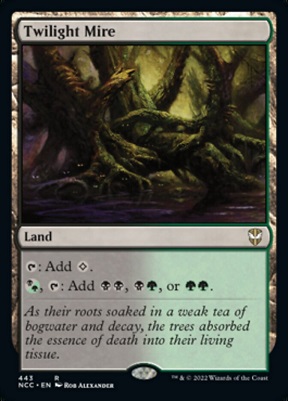
Filter lands, in my opinion, are one of the most underrated duals in the game. They are a bit riskier than shocks and fetches. Since you need other mana to facilitate them, there’s always a chance that you won’t be able to use them when you need to.
With that being said, however, these are the best in the game for meeting harsh mana requirements. For example, if your deck needs to produce triple green and triple black, filters can be a lifesaver.
Here’s the full list:
- Sunken Ruins
- Fetid Heath
- Fire-Lit Thicket
- Flooded Grove
- Mystic Gate
- Wooded Bastion
- Graven Cairns
- Rugged Prairie
- Twilight Mire
- Cascade Bluffs
Dual-Colored Man Lands
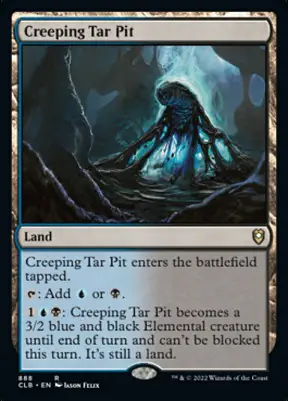
This cycle was first started in Worldwake and completed in Battle For Zendikar. These provide you with two different colors of mana. They do, however, always enter the battlefield tapped.
So what makes them good, then?
Well, they all have the ability to transform into creatures each turn. The strength and cost of the creature varies from card to card, with Creeping Tar-pit, Celestial Colonnade and Raging Ravine seeing the most play.
Full list below:
- Creeping Tar Pit
- Shambling Vent
- Raging Ravine
- Lumbering Falls
- Celestial Colonnade
- Stirring Wildwood
- Lavaclaw Reaches
- Needle Spires
- Hissing Quagmire
- Wandering Fumarole
Click over to the managathering website for a complete list of every dual-colored land ever printed in MTG, sorted by color.
RELATED: MTG Saga: Everything You Need to Know
Best Tri Lands
So we’ve gone over all of the best that tap for two colors. Now let’s talk about the best that tap for three different colors of mana.
Triomes
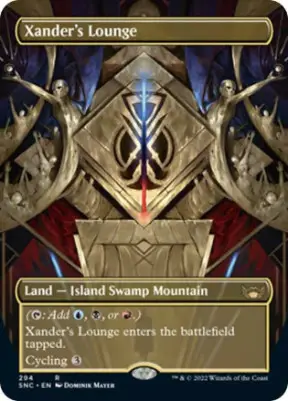
Triomes are a cycle of cards first introduced in Ikoria, Lair of Behemoths. Now with the release of Streets of New Capenna, the cycle is finally complete, meaning there’s a Triome for every possible color combination.
Triomes can serve as powerful fixtures for the ambitious deck-builder looking to utilize spells of many different colors. However, in Magic, great power never comes free.
Each of these Triomes must enter the battlefield tapped. This lofty downside means that players should be careful when considering them for inclusion in their decks.
Naturally, not all strategies can afford to have their resources delayed. If you have the right deck for it however, the positives far outweigh the negatives.
Commander is really the format that allows Triomes to shine the brightest. The slower pace of Commander naturally lessens the downside of them entering tapped. If your Commander deck is in three or more colors, and the Triomes are within your budget, adding them is a no-brainer.
Below is the full Triome list, beginning with five printed in Ikoria and ending with the final five printed in Streets of New Capenna.
- Indatha Triome
- Raugrin Triome
- Zagoth Triome
- Savai Triome
- Ketria’s Triome
- Jetmir’s Garden
- Ziatora’s Proving Ground
- Xander’s Lounge
- Raffine’s Tower
- Spara’s Headquarter
Best Utility
So now you know all about the best that are primarily used for mana-fixing. But now let’s take a look at the best utility lands in Magic: The Gathering.
These are all used primarily for some other purpose aside from producing mana. That can be powerful activated abilities, static abilities, or something else entirely.
Let’s get right into it!
Academy Ruins
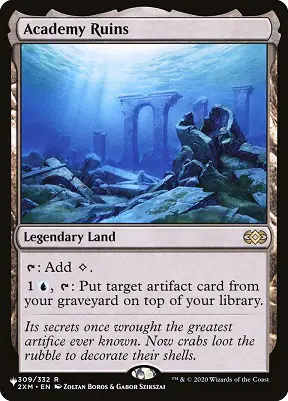
Starting off our list, is Academy Ruins. This is perfect for artifact decks, letting you bring an artifact from your graveyard to the top of your deck over and over again. Academy Ruins saw lots of play in its Standard format and continues to see play in Modern and Legacy to this day.
Dryad Arbor
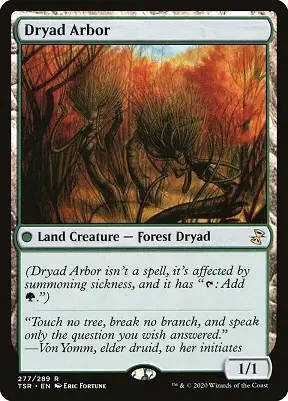
Dryad Arbor is a unique hybrid card. It functions both as a forest and a 1/1 dryad creature. This is great for aggro decks, or decks that rely on a high creature count, since it’s basically a zero mana 1/1 that can tap for mana.
The downside to Dryad Arbor, however, is that it takes up a land-drop, so it doesn’t really ramp you like a traditional mana-dork. And, of course, unlike a normal Forest, you can’t tap it for mana the first turn you play it.
Strip Mine
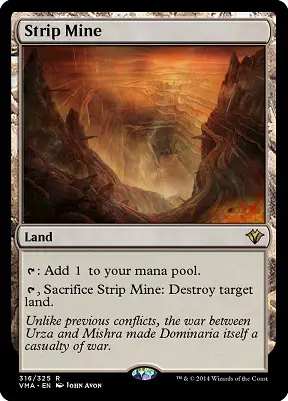
Strip Mine is great. Destroying your opponents best land is a devastating effect and can be a huge weapon in decks that can function with very little mana.
Strip Mine becomes even better when paired with cards that can return stuff to the battlefield.
Cabal Coffers
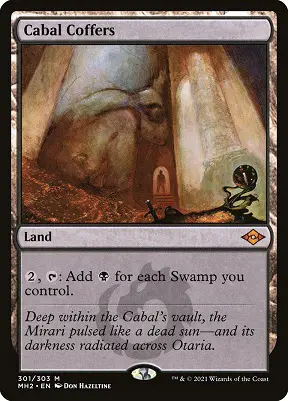
Cabal Coffers gives you a ton of mana if you have lots of swamps on the battlefield. This is, of course, easy to pull off naturally in mono-black decks. It also pairs well with cards like Urborg, Tomb of Yawgmoth to create crazy amounts of mana in multicolored decks as well.
Cabal Coffers has been a powerhouse in eternal formats for a while now, but with its printing in Modern Horizons 2, it has started to make an impact on Modern as well.
Nykthos, Shrine to Nyx
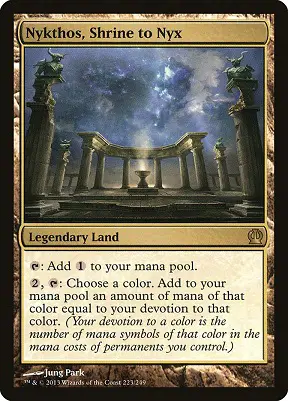
Nykthos, Shrine to Nyx is crazy in mono-colored decks. It taps for one colorless mana, and also has an ability which lets you pay two mana, tap it, and add X mana of a certain color, where X is your devotion to that color.
For those who might not be familiar, “devotion” is how many mana symbols of that color there are amongst permanents you control. So for example, if you have Phyrexian Obliterator on the battlefield, he gives you four devotion to black.
It’s not hard to imagine how you can make crazy amounts of mana using Nykthos, Shrine to Nyx in the right deck.
Serra’s Sanctum
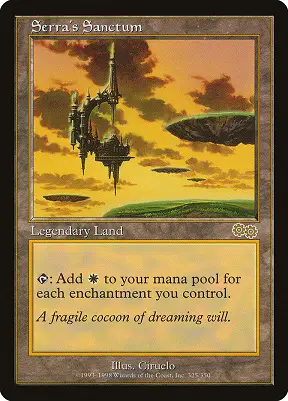
Serra’s Sanctum might be the least powerful of the legendary cycle from Urza’s Saga. Don’t think for a second, however, that Serra’s Sanctum isn’t powerful. It taps for one white mana no matter what. And it has the ability “Tap: Add one white mana for each enchantment you control.”
This can generate huge amounts of mana in enchantment decks, leading to easy combos.
Serra’s Sanctum is great in every format it’s legal in.
Urza’s Saga
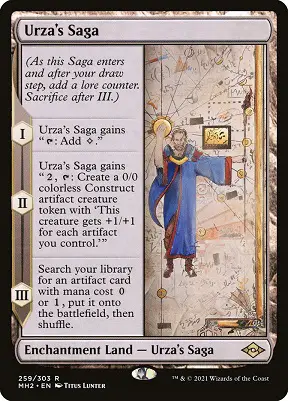
Urza’s Saga comes with three abilities. The last of these abilities is the most powerful.
On the third turn after it’s played, Urza’s Saga lets you search your library for an artifact card with mana-cost zero or one, and put it directly onto the battlefield. This is huge for a number of decks. It can tutor for combo pieces like Colossus Hammer[c] in Modern, and cards like [c]Sol Ring or Black Lotus in Commander and Vintage.
Library of Alexandria

Library of Alexandria is without a doubt one of the most powerful cards ever printed in Magic.
Pairing it with Land Tax is one of the oldest combos in Magic’s history, and part of the reason why LoA became restricted all the way back in 1994. It wasn’t just that combo however. Library of Alexandria simply gives too much easy card advantage. And it has zero color requirements making it an easy inclusion in too many decks.
Karakas

Upon first glance, Karakas might not seem crazy powerful, but if you ever play with or against this card, you’ll quickly realize how good it is.
Karakas taps for a white mana just like a basic plains, meaning there’s very little downside to including it in your deck. More importantly, it lets you return any legendary creature to its owners hand. All you have to do is tap Karakas, and any legend disappears. You can use the ability to remove your opponents legends, to protect yours, or to facilitate combos.
Tolarian Academy
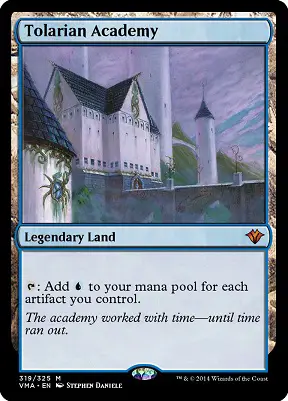
Tolarian Academy is, objectively, probably the best land ever printed in MTG. It’s so powerful that it had to be banned in Commander and Legacy, and restricted in Vintage.
You can tap it and get one blue mana for every artifact you control. It’s not hard to see how this is way too powerful in Commander where cheap mana-rocks are so widely used.
Although Tolarian Academy isn’t playable in most formats, it still deserves a spot on this list. After all, in terms of sheer power, it’s hard to beat Tolarian Academy.
Gaea’s Cradle
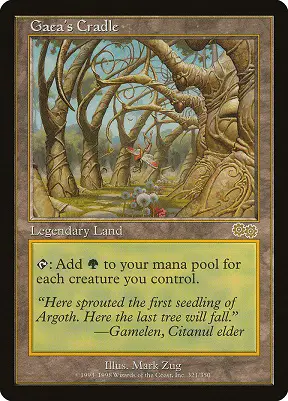
Last but definitely not least, is Gaea’s Cradle. This is the green card from the legendary Urza’s Saga cycle, and one of the most famous and beloved cards in all of MTG.
Gaea’s Cradle gives you one green mana for every creature you control. This is just so good in so many decks. Really, almost every green Commander deck in existence wants Gaea’s Cradle.
The Cradle is also great in Legacy, where it’s best abused in Elves decks.
Gaea’s Cradle isn’t just one of the best lands of all time, it’s also one of the best cards of all time.
RELATED: What Is cEDH? Your Questions Answered
Honorable Mentions
There are so many great cards out there. It’s almost impossible to cover them all in depth. That doesn’t mean they should be left out all together though. Feel free to browse this list any time you’re looking for amazing utility lands to include in your decks.
- Valakut, the Molten Pinnacle
- Cabal Stronghold
- Castle Locthwain
- Bojuka Bog
- Urborg, Tomb of Yawgmoth
- Phyrexian Tower
- Reliquary Tower
- Rishdan Port
- Seat of the Synod
- Ancient Den
- Minamo, School at Water’s Edge
- Oboro, Palace in the Clouds
- Tolaria West
- Mystic Sanctuary
- Pendelhaven
- Emaria, the Sky Ruin
- Boseiju, Who Endures
- Vault of the Archangel
- Castle Vantress
- Eiganjo Castle
- Temple of the False God
- The World Tree
Best Miscellaneous
City of Brass
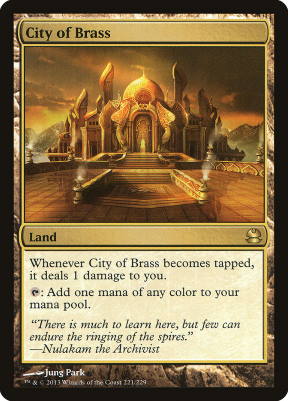
City of Brass is the ultimate pain land. It deals one damage to you whenever it becomes tapped, but you can tap it for any color of mana! The one downside, of course, is that, unlike other pains, you can’t tap it for colorless without taking damage.
Still, City of Brass is an amazing choice for any decks that use three or more colors.
Ancient Tomb
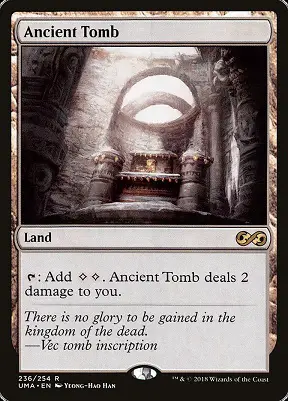
Ancient Tomb is amazingly simple and effective. You tap it, you get two colorless mana, and it deals two damage to you. While this might seem costly, it’s well worth it in most situations to get such easy and valuable ramp.
Tron
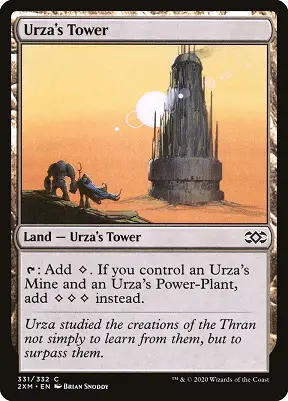
No list would be complete without mentioning these three cards. These don’t do much individually, but when you get all three of them together, that’s when the magic happens.
Once you assemble the trio, Urza’s Powerplant, and Urza’s Mine both tap for two colorless mana each, and Urza’s Tower taps for three. That gives you a total of seven mana!
Tron decks have lots of ways to find all three of these, making it pretty easy to assemble the trio by turn three or four.
Dropping a turn three Karn Liberated with these is one of the most loved and hated plays in all of MTG.
Whichever side of the tron fence you’re on, however, you can’t argue that these are some of the best lands ever printed.
End Step
There you have it! The best lands in all of Magic: The Gathering’s history. I hope you’ve found this article useful. If you have any questions, be sure to leave a comment below. Or if I forgot to include something, make sure to comment that as well.
Now, what are you waiting for? Get out there and start putting some of these wonderful lands to use!
